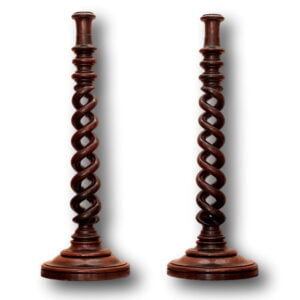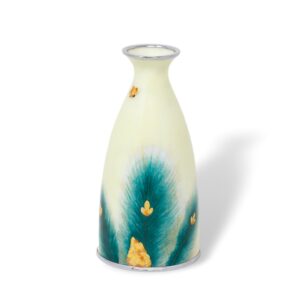Description
Casket-form Napoleon III box with enamel panels and phoenix feet
From our Decorative collection, we are delighted to offer this exceptional French Limoges Enamel Jewellery Box dating to the Napoleon III period, circa 1870.
The jewellery box, of rectangular casket form, is richly mounted in detailed ormolu (gilt bronze) and raised on four mythical phoenix feet. A loop handle crowns the lid, framed by intricate acanthus and floral borders that showcase the opulent taste of late 19th-century French design.
Each side of the box is set with a finely painted Limoges enamel panel, individually hand-enamelled with classical figures, cherubs, mythological animals, and fruit garlands. Two portraits stand out, one depicting Julius Caesar with a laurel wreath, and another representing Daphne, adorned with similar classical motifs.
The hinged lid opens to reveal a purple velvet-lined interior, complete with gilt mounts and compartments ideal for jewellery or personal accessories. This beautiful piece embodies the elegance of the beginnings of the Belle Époque era, blending the precision of Limoges enamelling with the richness of French bronze work.
A refined and decorative jewel box that captures the spirit of Napoleon III France, perfect for collectors of fine 19th-century French objets d’art.
Limoges
Limoges enamel has been produced in south-western France since the 12th century, first using the champlevé technique for religious objects and later evolving into painted enamel during the Renaissance. Workshops in Limoges became known for their intricate narrative scenes, gilded decoration and strong colouring, with pieces now held in major museum collections such as the Louvre, the British Museum and the Metropolitan Museum of Art. Collectors value Limoges enamel for its link to medieval devotional art and Renaissance court taste, with signed family workshops and early examples especially sought after.
For further information on Limoges please see our article The History and Techniques of Limoges Enamel.
Daphne
is a nymph or huntress of Artemis. Her parentage varies, depending on the source, but it’s generally understood that her father is a river god Peneus (Ladon) and her mother was either the nymph Creusa (Gaia).
BRONZE
Bronze has been one of the most widely used materials in art and design for centuries, valued for its strength, durability, and ability to capture fine detail. Popular from ancient civilisations to the 19th century, bronze has been used for statues, decorative objects, and functional pieces alike. In the late 19th century, artists in Vienna, including Franz Xaver Bergmann, perfected the technique of cold-painting, adding rich layers of colour to bronze without firing. This innovation, along with the timeless appeal of bronze’s patina and texture, ensures that antique bronze objects remain highly collectible today.
For further information please see our article Bronze Sculpture: History, Composition, and Casting Techniques.
BELLE ÉPOQUE PERIOD (1871–1914)
The Belle Époque, meaning “Beautiful Era,” was a golden age of French and European culture, spanning from 1871 to 1914. This period was defined by optimism, innovation, and artistic achievement, particularly in Paris, the centre of fashion, decorative arts, and design. Art Nouveau flourished, alongside exquisite creations in silver, bronze, glass, and jewellery, produced by celebrated makers for an international audience. Collectors prize Belle Époque pieces for their elegance, refined detail, and the way they reflect the cultural sophistication of late 19th and early 20th-century France.
For further information please see our article The Belle Époque Era in France: Art, Antiques and a Golden Age of Creativity.
Napoleon III
(Second Empire style), was a highly eclectic style of architecture and decorative arts which used elements of many different historical styles and also made innovative use of modern materials. It flourished during the reign of Napoleon III (1852-1871) in France and had an important influence across Europe and North America. Major examples of the style include the Opéra Garnier, the Bibliothèque nationale de France, the Church of Saint Augustine, and the Philadelphia City Hall.
ENAMEL
(vitreous enamel) also known as porcelain enamel, is a material made by fusing powdered glass to a substrate by firing, usually between 750 and 850 °C. The powder melts, flows, and then hardens to a smooth, durable vitreous coating. The word vitreous comes from the Latin vitreous, meaning “glassy”.
Ormolu
is the technique of applying finely ground, high-carat gold–mercury amalgam to an object of bronze. The mercury is driven off in a kiln leaving behind a gold coating. The French refer to this technique as bronze doré and in English it is often referred to as gilt bronze. It is a finishing technique which adds an overall gold look to any object without the massive cost and impracticality of making an object out of solid gold. Mercury was outlawed in the 1830’s in France however it was still used until the early 1900s.
CONDITION
Very Good Antique Condition
MEASUREMENTS
12.5cm High x 14.5cm Wide x 12cm Deep (4.9 x 5.7 x 4.7 Inches)
With every purchase from Jacksons Antique, you will receive our latest product guide, certificate of authenticity, full tracking information so you can monitor your shipment from start to finish and our personal no-hassle, money-back policy giving you that extra confidence when purchasing.



























